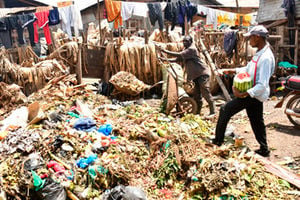
Writer: Howard Mwesigwa. PHOTO/FILE/COURTESY
The recent disaster at the Kiteezi landfill has sent indescribable shockwaves throughout the nation, shedding light on the deplorable nature of our waste management practices and the pressing need for more prudent environmental governance. As the country grapples with the abysmal impact of this catastrophe, the Kiteezi incident serves as a harsh reminder of the cost of inaction and environmental maladministration.
This cataclysmic incident calls for immediate course-correction and mindset change on waste generation and management in Uganda, especially in rapidly urbanising areas like the Kampala Metropolitan area.
The landfill has long been the primary dumping ground for the Kampala Metropolitan area. For years, it has grappled under the weight of increasing waste volumes, about1,300 tonnes daily, a reflection of the rapid urbanisation and population growth in the capital. Initially designed as a temporary solution, the landfill became a permanent fixture, operating beyond its intended capacity.
Despite several warnings, all the way from 2005 and 2008, from environmental experts about the risks tangential to its continued use, little was done to address the underlying concerns until recently, when calamity struck.
The collapse of the Kiteezi landfill was a disaster in the offing. Over the years, the landfill has been plagued by unsustainable waste management practices, inadequate oversight, and a lack of meaningful community engagement. This disaster has exacerbated environmental degradation, including the contamination of nearby water sources, destruction of local ecosystems, and the release of harmful gases like methane, into the atmosphere.
The human toll has also been severe, with more than 20 people reported dead so far, and communities facing public health risks from exposure to toxic substances and the destruction of their homes and livelihoods.
This disaster is an indictment on Uganda’s environmental governance architecture! It has exposed significant lacunae in the enforcement of environmental laws and regulations.
Notwithstanding the existence of laws and policies, like the National Environment Act, Cap 181, the National Environment (Waste Management) Regulations, 2020, the NEMA Guidelines for The Management of Landfills in Uganda, the Solid Waste Management Ordinance, 2000 and the National Strategy for Promoting Plastics Circularity in Uganda 2023-2028, designed to ensure safe and sustainable waste management, there has been a general lack of political will to implement them, with enforcement agencies lacking the resources and political backing to carry out their mandates effectively. The Kiteezi disaster has highlighted the need for more robust regulatory oversight, better coordination among government agencies, and enhanced investment in sustainable waste management practices and infrastructure.
Beyond the immediate response to the disaster, there is a critical need for a long-term strategy to prevent analogous incidents in the future. This includes the development of modern waste management, waste-to-energy, and incineration facilities that are designed to handle the growing volume of waste generated in urban areas.
Investment in recycling and waste reduction initiatives is also crucial, as is the need to raise public awareness about the importance of proper waste disposal. Additionally, the role of local communities in waste management should be emphasised, with efforts made to involve them in decision-making processes and to address their concerns.
The Kiteezi landfill disaster is a stark reminder of the ramifications of ignoring environmental risks and the need for a more proactive, rather than reactionary approach to environmental governance. It is imperative that lessons are drawn from this tragedy, and that decisive action is taken to prevent such a disaster from ever occurring again. Finally, we must hold the duty-bearers accountable!
Howard Mwesigwa is the Team Leader – Energy, Environment and Sustainability at Kalikumutima & Co. Advocates.
[email protected]








